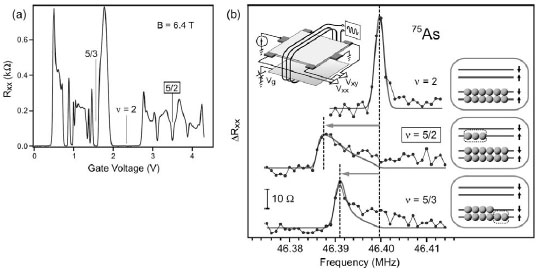1Physical Science Laboratory, 2Japan Science and Technology Agency
Fundamental particles in nature are classified as either fermions or bosons
according to how the wave function changes sign with interchange of two
particles. Remarkably, behavior of particles in a correlated state is often
described in terms of quasiparticles possessing properties different from
those of the original particles. In two dimensions, a quasiparticle behaving
differently from fermions or bosons is theoretically possible. In particular,
theory predicts the existence of quasiparticles with exceedingly unusual
properties. These quasiparticles, known as non-Abelian quasiparticles,
whose interchange takes the system from one of its many ground states to
another, have attracted strong interest from both theory and experiment
as it would establish the foundation for topological quantum computing-an
entirely novel architecture for error free quantum computation [1].
Fractional quantum Hall states that emerge in a two-dimensional electron
system confined to a heterointerface of pristine semiconductor crystals,
such as GaAs/AlGaAs, are expected to host such exotic quasiparticles that
are neither fermions or bosons. Of particular interest is the one at Landau
level filling factor ν = 5/2 [2], which is predicted to support non-Abelian
quasiparticles. However, unlike other states, the exact origin of the ν
= 5/2 state remains unknown. The likely candidates for its wave function
that emerged through experiment [3] include one that does not support non-Abelian
quasiparticles. Exploiting the fact that these wave functions have different
spin states, we have demonstrated for the first time that all the electrons
in the ν = 5/2 state have their spins fully polarized along the applied
field using resistively detected nuclear magnetic resonance (NMR) (Fig.
1) [4]. With our results, possible theoretical models are narrowed down
to only those supporting non-Abelian quasiparticles.
[1] C. Nayak et al., Rev. Mod. Phys. 80 (2008) 1083.
[2] R. L. Willet et al., Phys. Rev. Lett. 59 (1987) 1779.
[3] I. P. Radu et al., Science 320 (2008) 899.
[4] L. Tiemann, G. Gamez, N. Kumada, and K. Muraki, Science 335 (2012) 828.
 |
||
|